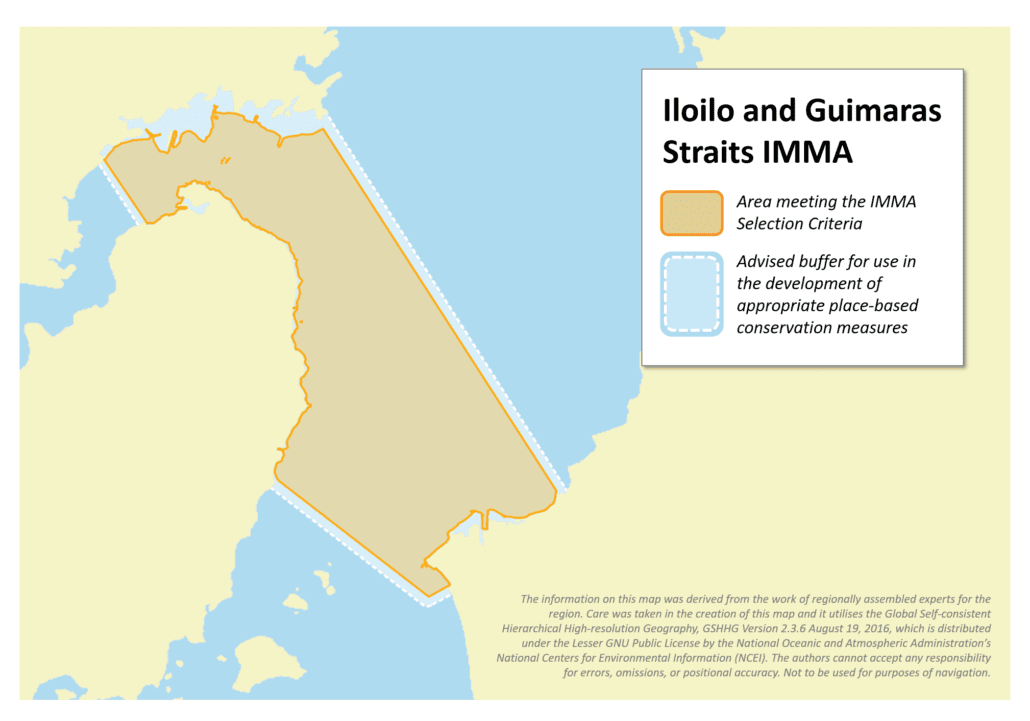Iloilo and Guimaras Straits IMMA
Size in Square Kilometres
340 km2
Qualifying Species and Criteria
Irrawaddy dolphin – Orcaella brevirostris
Criterion A; B (1)
Marine Mammal Diversity
Tursiops aduncus, Grampus griseus, Pseudorca crassidens, Kogia sima,
Stenella attenuata, Dugong dugon, Globicephala macrorhynchus
Download fact sheet
Summary
The lloilo and Guimaras Straits are shallow bodies of water connecting the Sulu and Visayan Seas in the Central Philippines. This area hosts one of two Critically Endangered subpopulations of Irrawaddy dolphins (Orcaella brevirostris) in the Philippines. Estimated to number fewer than 30 individuals, this resident population is decreasing as a result of fisheries bycatch and vessel strikes. Sightings of Irrawaddy dolphins in this IMMA are concentrated in areas with freshwater inputs from rivers on the islands of Panay, Guimaras and Bago-Pulupandan, Negros.
Description of Qualifying Criteria
Criterion A – Species or Population Vulnerability
The Irrawaddy dolphin, Orcaella brevirostris, is an endangered marine mammal found only in the Indo-Pacific region. Small isolated populations are often centred near estuaries and in semi-enclosed, protected bodies of water with freshwater inputs, such as bays, lagoons, and river systems (Arnold, 2002, Reeves et al. 2008). Until recently, the Malampaya Sound population in Palawan, declared by the IUCN as Critically Endangered (Minton et al. 2017), was the only population known in Philippine waters (Dolar et al. 2009). A second population was found in the Visayas in 2007, more than 300 km from the island of Palawan (de la Paz et al. 2017, 2020). The population exists in an estuary and very close to human fishing grounds, making the dolphins vulnerable to boat strikes and fishing gear entanglement. In 2010 one calf stranded on the Guimaras coast and in 2011 two animals (mother and calf) stranded on Negros (Dolar, 2012). This constitutes 4% mortality for 2010,and 8% for 2011 (Dolar, 2012). This is above the 1-2% threshold considered sustainable for cetaceans. One mortality every year indicates that the population decline is unsustainable. Identified threats include possible net entanglement, boat collisions, pollution from industrial plants, habitat destruction, prey depletion, and the Philippine government’s plan to construct a bridge to connect the 3 islands, which will cut directly across the Irrawaddy dolphins’ habitat. Interviews with elderly fishers and residents conducted at that time suggested that the dolphins’ habitat has shrunk considerably and their numbers have declined dramatically in the last 15-20 years.
Criterion B: Distribution and Abundance
Sub-criterion B1: Small and Resident Populations
Only a very small population of Irrawaddy dolphins occurs in this area. The first population estimate using recapture and photo-ID techniques made in 2010-2012 was 23 dolphins (CV=23.6%, 95% CI of 15-36 dolphins) (Dolar, 2012). The second estimate using the same method made in 2013-2014 was 21 dolphins (CV=25.5%, 95% CI 10-31 dolphins) (SU-IEMS Report, 2014), and the most recent report is 13 individuals (C.V.=20.89%; 95% CI=9-19 dolphins) (de la Paz et al. 2017).
Supporting Information
Alava, M.N.R., Dolar, M.L.L., Sabater, E.R., Aquino, M.T.R. and Santos, M.D. (eds.). 2012. Red List Status of Marine Mammals in the Philippines. Bureau of Fisheries and Aquatic Resources – National Fisheries Research and Development Institute. 194 pages.
Arnold, P.W. 2002. Irrawaddy dolphin (Orcaella brevirostris) In “Encyclopedia of Marine Mammals”. In W.F. Perrin, B. Würsig, and J.G. M. Thewissen, eds., pp. 652-654. Academic Press, London, UK.
Casipe, K.P., Espinosa, K.E.S., Jarabello, C.J.M. and de la Paz, M.E.L. 2016. Foraging behavior association between Irrawaddy dolphins (Orcaella brevirostris) and tidal net fisheries in the coastal waters of Pulupandan, Negros Occidental, Philippines. Sylvatrop Technical Journal of Philippine Ecosystems and Natural Resources 25 (1 & 2)
de la Paz, M.E.L., Casipe, K.P., Lirazan, M.G., Espinosa, K.E., Yulo, E.V.R., Valderrama, M.T.K., Jarabello, C.J., and Dolar, M.L.L. 2017. Irrawaddy dolphins of Bago-Pulupandan: Updated Population Estimate, Habitat Use and Fisheries Interactions. Technical Report submitted to the Protected Areas Management Enhancement Project of the Department of Environment and Natural Resources of the Republic of the Philippines and the Deusche fur Gesellschaft Internationale Zusammenarbeit (GIZ) GmBH of the Republic of Germany
de la Paz, M.E.L., Lirazan, M.G., Casipe, K., Yulo, E.V.R. and Barcelona, A.L.B. 2017. Preliminary observations of cutaneous nodules in Irrawaddy dolphins (Orcaella brevirostris) in Guimaras Strait, Philippines. 22nd Biennial Conference on the Biology of Marine Mammals, 22-27 October 2017. Halifax, Canada.
Dolar, M.L.L., Sabater, E.R., and de la Paz, M.L. Forthcoming. Distribution, population size and conservation status of the Irrawaddy dolphin, Orcaella brevirostris, in the Visayas, Philippines. Raffles Bulletin of Zoology xx: xx-xx
Dolar, M.L.L., Aquino, M.T., Sabater, E.R., Solis, E.F.D. and Perrin, W.F. 2009. Preliminary results on the ecology and conservation on a newly discovered population of Irrawaddy dolphins in Iloilo Strait, Philippines. 18th Biennial Conference on the Biology of Marine Mammals, 12-16 October 2009. Quebec City, Canada.
Hines, E. and contributors. 2012. Asian Dugongs. In Hines, E., Reynolds, J., Mignucci-Giannoni, A, Aragones, L.V., and M. Marmontel (Eds.), Sirenian Conservation: Issues and Strategies in Developing Countries. The University Press of Florida (reviewed in Mammalia and the Quarterly Review of Biology in 2014).
Minton, G., Smith, B.D., Braulik, G.T., Kreb, D., Sutaria, D. and Reeves, R. 2017. Orcaella brevirostris. The IUCN Red List of Threatened Species 2017. Available at: < http://dx.doi.org/10.2305/IUCN.UK.2017-3.RLTS.T15419A50367860.en>
Reeves, R.R., Jefferson, T.A., Karczmarski, L., Laidre, K., O’Corry-Crowe, G., Rojas-Bracho, L., Secchi, E.R., Slooten, E., Smith, B.D., Wang, J.Y. and Zhou, K. 2008. Orcaella brevirostris. The IUCN Red List of Threatened Species 2008: e.T15419A4579987.


